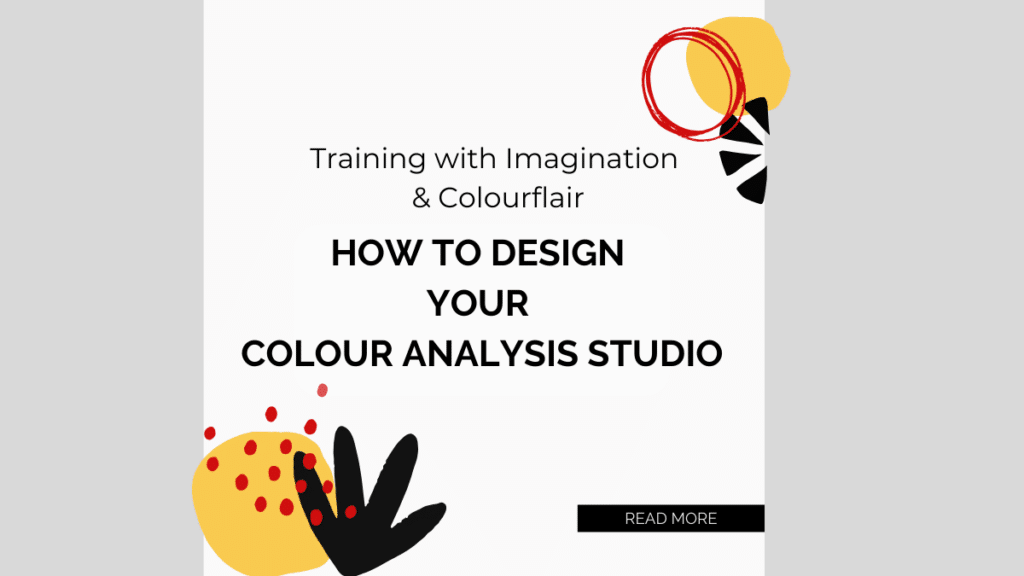Impress Clients and Elevate Your Business
Setting up a personal colour analysis studio or workspace is key to creating a professional and comfortable environment for your clients. In our blog today, we give you 10 useful tips to consider and help you get started:
1. Lighting
- Natural light: The best lighting for a colour analysis studio is indirect natural daylight, as it offers the truest representation of colours. If possible, place your workspace near a window, but avoid direct sunlight, which can cast shadows.
- Full-spectrum lighting: When natural light is unavailable or inconsistent, consider investing in full-spectrum bulbs. These mimic daylight and provide an accurate colour environment. If you are studying with us in the UK, you’ll receive the correct bulbs for Colour Analysis with your colour kit.
- Avoid harsh or yellow lighting: Regular indoor lighting, like incandescent bulbs, can distort colours, making it difficult to achieve accurate results.
2. Neutral Background
- Walls and furnishings: Use neutral tones (grey, white, or beige) for your walls and furniture. Bright or bold colours in the background can interfere with your client’s true colouring and reflection in the mirror.
- Backdrop: Consider using a plain neutral backdrop behind your client in your colour analysis studio. This will eliminate any colour interference from the surrounding environment.
3. Comfortable Client Seating
- Adjustable chair: Make sure your client has a comfortable, adjustable chair. They’ll need to be at eye level with you. A chair without a backrest might be preferable to help support your client during the analysis.
- Mirror: A large mirror at a comfortable angle will let your clients to see the process and be involved in their analysis. Additional lighting around the mirror can be helpful especially during winter months in the UK.
4. Drapes
- Organized drapes: Keep your seasonal drapes organized by colour categories for easy access. We use labelled drapes for quick identification during sessions.
5. Full-Length Mirror
- For personal reflection: A full-length mirror can help your client visualize how the colour palette works with their entire look and body proportions.
6. Workspace Layout
- Efficient setup: Keep essential tools—like your colour drapes, fans, and makeup samples—easily accessible without cluttering your workspace.
- Client’s view: Make sure the client has a clear view of the mirror and the draping process, while you can move freely to compare colours from different angles.
7. Storage
- Swatch organization: Use storage solutions like drawers or labelled containers to organize your colour palettes, drapes, and tools.
- Clear containers: Consider transparent or labelled storage bins to make finding tools quick and efficient.
8. Professional Tools
- Neutral cape: A neutral-coloured cape is essential to eliminate the influence of the client’s clothing on the analysis.
- Makeup testing station: Set up a small area where you can show makeup application for each seasonal palette. Keep a variety of makeup shades (lipsticks, eyeshadows, blush) for demonstrations.
9. Colour Analysis Studio – Consultation Area
- Relaxed seating: Have a designated space where you can discuss the results of the analysis with the client. This can include a cozy seating area with a table for reviewing swatches and colour guides, and a display book with testamonials from your happy customers.
- Reflection journal: Provide a space for the client to note down observations during the process.
10. Colour Wheel & Theory Charts
- Display for reference: Hang colour theory charts or a colour wheel for easy reference during analysis, explaining how complementary colours work and why certain shades enhance a client’s appearance.
For the best client experience, you’ll need to consider the overall atmosphere in the colour analysis studio. You could have some soft music playing in the background. Fresh air, and pleasant scents can make the space calmer and more inviting for your client.
By combining these elements, you’ll create a functional, professional, and welcoming environment that enhances the colour analysis experience for your clients. In our Colour Analysis Diploma course there is more detailed information on this topic…you can find out more about our home study course by clicking the link below:

